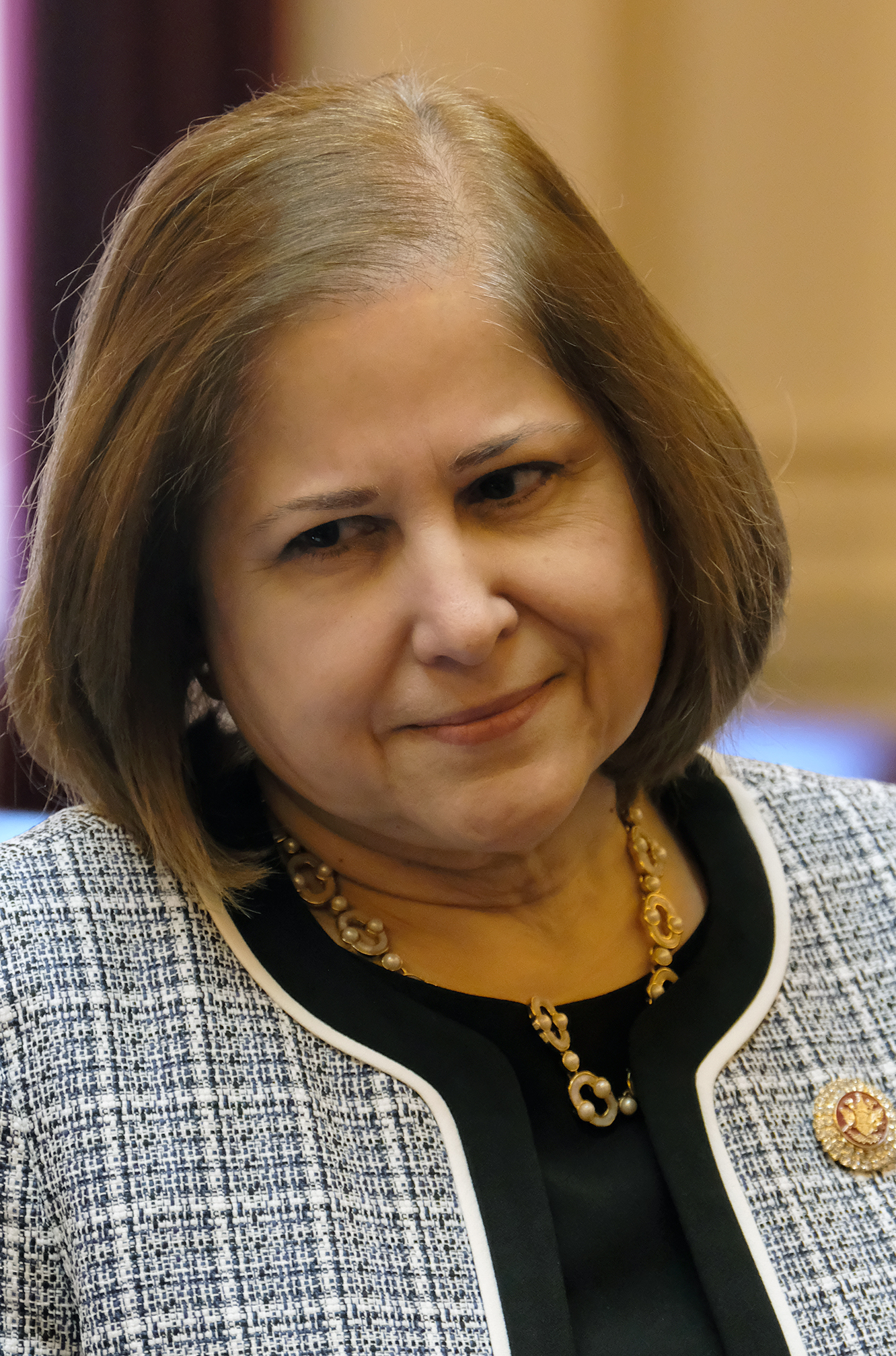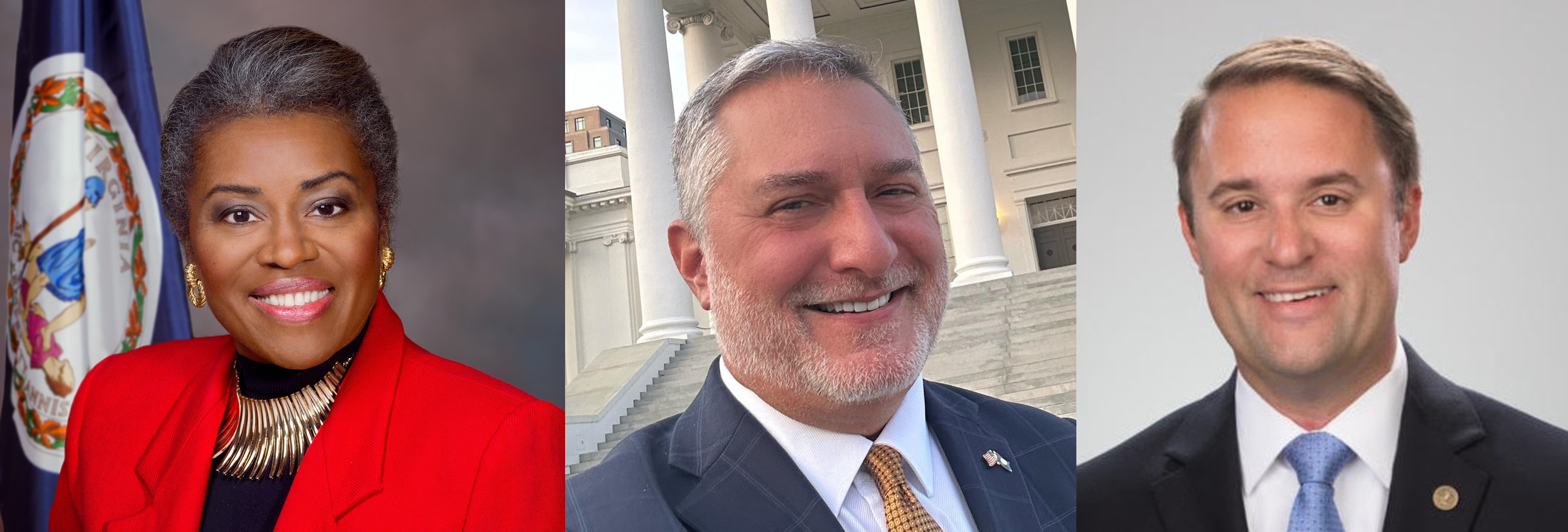Winsome Earle-Sears, the Republican candidate for governor, hasn’t seemed very enthusiastic about her fellow Republican running for lieutenant governor, John Reid. She put off appearing with him in the way that ticketmates traditionally do, and when they finally did — on a rally stage in Fairfax County — she didn’t interact with him.
By contrast, Democrat Abigail Spanberger has appeared with all her running mates and, at an event in Roanoke, shared a hug with her party’s candidate for lieutenant governor, Ghazala Hashmi.
It’s easy to speculate about the reasons why — Earle-Sears is socially conservative and Reid is gay. Nonetheless, Earle-Sears would be better off if she spent some time listening to Reid on the stump.
The Republican ticket this year has faced a unique (and potentially disastrous) challenge: President Donald Trump’s downsizing of the federal government. This challenge comes in two parts.
The economic challenge is that the federal government is the main economic driver in Northern Virginia, which is also the state’s economic engine, accounting for 42% of state tax revenues. Any disruption in the Northern Virginia economy will be felt statewide, all the way to its southwestern corner, where Scott County gets about two-thirds of its funding from the state.
The political challenge is that, to win a statewide election, Republicans need to cut into the Democratic margins in bright blue Northern Virginia. Trump’s job-cutting seems likely to energize a big Democratic turnout, something Republicans can ill afford.
Throughout the campaign, Earle-Sears has had difficulty responding to these cuts. In March, she infamously told a group that “it’s not unusual” for someone to lose a job, so the federal cuts aren’t “a huge, huge thing.” She said she “couldn’t understand” why they were such big news.
Last week, in a contentious interview on CNN, Earle-Sears again seemed to dismiss the impact of these job cuts. “If this is the way you want to go, then go ahead, but I’m just not going to participate, because I want to talk about real issues,” she told the interviewer. The Spanberger campaign’s response was to immediately turn Earle-Sears’ comments into an ad that is now targeted at Northern Virginia voters. This is a self-inflicted wound.
The problem with Earle-Sears’ answer is twofold. First, it’s economically wrong. Job losses in Northern Virginia ought to be of concern statewide for the reasons I laid out; rural areas — Republican-voting areas — depend on tax revenue from Northern Virginia.
The bigger problem is that her reply lacks empathy. Candidates alone don’t get to determine what the issues are; voters have a say, too, and I imagine for lots of people in Northern Virginia, the loss of a job is a “huge, huge thing.” While it might be politically easy for a Republican to dismiss the concerns of federal workers — or, in many cases, former federal workers — in Northern Virginia, the tone here seems all wrong. If Earle-Sears doesn’t seem to care about workers in Northern Virginia losing their jobs, would she care about workers elsewhere losing their jobs? Her response here is not offering any confirmation that she would. The risk for Republicans is not that voters in some 80% red county in Southwest will suddenly develop a blue streak, but that they simply won’t care — and not bother to vote. Republican-voting rural areas, particularly those in Southwest, already have some of the lowest turnout rates in the state; Republicans can’t afford for them to go lower. On the contrary, they need to drive those turnout rates higher.
That got me wondering: What would be a good Republican response to these cuts? A Republican candidate in some other state can easily say they were necessary, even desirable, and perhaps get applauded. However, a Republican whose state is home to more federal workers than any other except California is in a different position. Is there any good answer a Virginia Republican can give without going against a president from their own party?
This week, I think I heard one — from John Reid.
Reid spent two days this week campaigning west of the Blue Ridge — in Waynesboro, Roanoke County, Galax and Christiansburg. I went to his Roanoke County event, a lunch meeting with about two dozen party activists at Four Nineteen West restaurant. In the question-and-answer session that followed Reid’s stump speech, one of the Republicans asked Reid about the federal job cuts.
“I will never make fun of someone who lost their job,” he said. He then proceeded to criticize Elon Musk’s clownish showmanship (my words, not his), where he wielded a chainsaw to brag about cutting federal jobs. That was ill-advised, Reid said. “It hurt a lot of people’s feelings.”
He then went on to contrast Northern Virginia with other parts of the state. “In Northern Virginia, they have a robust, deep economic situation,” whereas many communities don’t. He talked about how many places have been through painful economic transitions — and are still going through them, such as the coal counties of Southwest Virginia. “I always want to be empathetic but they have other jobs,” he said of Northern Virginia.
From a policy perspective, Reid’s answer may be no different from Earle-Sears’, but tonally it is quite different. If you disagree with that policy, then maybe it doesn’t matter what the tone on the other side is like, but tone does go a long way in politics. Just look at how popular Glenn Youngkin is in Virginia vis-à-vis Donald Trump, even though their policies might overlap.

For the record, Hashmi certainly disagrees with Trump’s policy of reducing the federal workforce. Among her recent comments is this one: “With Trump cutting 30,000 public servant jobs, many of them Virginians serving Virginia veterans, why won’t our statewide leaders fight back? Virginia needs executive leadership that will fight for our public servants and veterans, not bend the knee in subservience to Trump.”
If some private company were cutting this many jobs in Virginia, the governor would at least make a call to see if that could be avoided. Here, Republicans can’t do that, but they would be better off politically if they could find some different language with which to address the situation.
Reid, though, at least acknowledges a problem that Earle-Sears doesn’t seem to want to. He also does a better job pivoting to the logical follow-up: We need to diversify the Northern Virginia economy. Earle-Sears talks about growing the economy, too, but I have to wonder how many people are listening after she says job losses aren’t “a huge, huge thing.”
One of the lessons taught in many leadership classes is a rhetorical one: To get people to listen, you have to meet them where they are, not where you want them to be.
Republicans have some facts on their side: The unemployment rate in Northern Virginia remains quite low — and, in some cases, lower than the state average of 3.5%. As of June, it’s 3.4% in Arlington County, exactly 3.5% in Alexandria and Loudoun County, 3.6% in behemoth Fairfax County. In other words, Northern Virginia is pretty much normal compared to Virginia as a whole.
Democrats have some facts on their side, too: All these rates have risen since a year ago. A year ago, Virginia’s unemployment rate was just 2.7%. That’s exactly where Fairfax County was, too. A change from 2.7% to 3.6% may not seem like much, but it’s a 33% increase. In Falls Church, unemployment has gone from 2.6% to 4.0% in a year’s time — that’s almost a 54% increase.
Democrats have something else on their side, too: fear — and fear is not to be discounted as a political motivator. These are not communities that are accustomed to seeing a lot of unemployment — so the unemployment that’s happening now casts a long shadow from what might seem relatively small statistics.
There are parts of Virginia where unemployment is traditionally higher — and it’s rising, too. In Buchanan County, the unemployment rate in June was 6.3%, up from 4.6% a year ago. In Emporia, it’s also 6.3%, up from 4.9%.
Pulaski County had the state’s highest unemployment rate in June: 8.0%, more than double the 3.1% it was last year at this time. Pulaski’s numbers have been spiked by the same thing that has pushed up unemployment in Northern Virginia — Trump. That’s not me saying that; that’s Volvo, which cited tariffs as one of the reasons for the layoffs at its Dublin plant.
Every locality west of the Roanoke Valley has a higher unemployment rate than the highest unemployment rate in Northern Virginia. The same holds true across Southside, as well, where unemployment tops out at 6.2% in Danville and Prince Edward County until you get to Emporia at 6.3%.
Reid says these communities have a certain “stoicism.” That’s true. It’s also true that many of these places have long felt ignored and left behind in a way that Northern Virginia has not been. It’s also true that these communities are not economic engines the way Northern Virginia is, so their economic misfortunes get less attention. Perhaps, though, just perhaps, if a candidate shows some concern about a community where the unemployment rate has risen from 2.7% to 3.6%, they’ll also show concern about a community where it’s risen from 3.1% to 8.0%. At least that’s the hope, anyway. However, if a candidate is dismissive of the unemployment in the first locality, then what is the threshold at which the candidate does become concerned?
In politics, emotion is often more powerful than policy. Voters are quite capable of deciding whose policies they prefer, but from what I’ve heard, when it comes to an issue that is difficult for Virginia Republicans, Reid does a better job of trying to make an emotional connection than Earle-Sears has so far — or at least trying to avoid the emotional backlash that her response might provoke.
We’re not just electing a governor this year


We’re also electing a lieutenant governor, attorney general, all 100 members of the House of Delegates and many local offices, including boards of supervisors and school boards in some communities. We also now have listings on our Voter Guide for every city and county in Virginia, where you can see who’s on your local ballot. Early voting begins Sept. 19.
Want more politics? Sign up for West of the Capital, our weekly political newsletter:



